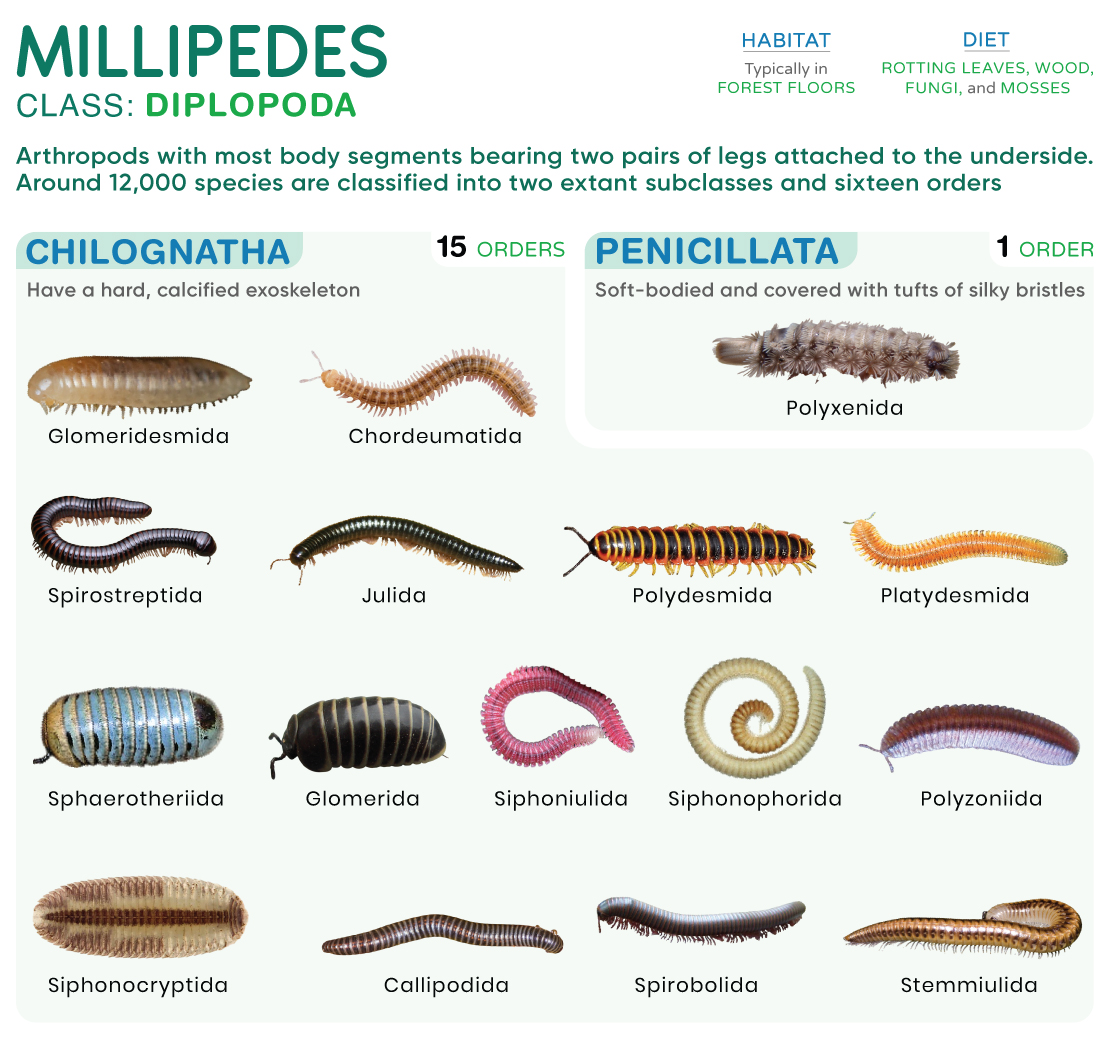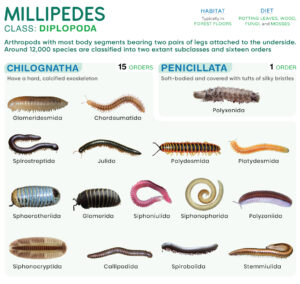


Millipedes are slow-moving arthropods having long, segmented bodies, with most segments bearing two pairs of legs attached to the underside of the body. They constitute the class Diplopoda within the subphylum Myriapoda. The name ‘millipede’ derives from the Latin words ‘mille’, meaning thousand, and ‘pes’, meaning foot. However, most species bear only between 34 and 400 legs.

Found on all continents except Antarctica, these arthropods are primarily detritivores, feeding on decaying plant matter.
The largest millipede, the giant African millipede (Archispirostreptus gigas), grows up to 13.2 in (33.5 cm) in length and 2.6 in (67 mm) in width. In contrast, the smallest millipedes, which belong to the genus Siphoniulus, are only around 0.30 in (7.5 mm) long and 0.01 in (0.25 mm) wide.
These arthropods have either cylindrical or flattened, elongated bodies, divided into numerous metameric segments. Their exoskeleton is typically brown to black in color, and thus, they can easily remain camouflaged in the soil. In members of the subclass Penicillata, the exoskeleton is soft, uncalcified, and covered by fine bristles, whereas those of the subclass Chilognatha possess a calcified exoskeleton.
The head bears a pair of large mandibles supported by a plate-like jaw lip or gnathochilarium. Unlike centipedes, which have long, threadlike antennae, millipedes bear a pair of short, elbowed (geniculate) antennae. While some millipedes are blind, most possess clustered simple eyes or ocelli with flat lenses.
The first segment that follows the head, known as the collum, lacks legs. The second to fourth segments, known as haplosegments, bear a single pair of legs each. Each of the remaining segments, called diplosegments, bears two pairs of legs, unlike centipedes, which have a single pair of legs on all body segments. The final body segment, the telson, is legless and bears a preanal ring, the anus, and a pair of anal valves.
Individuals of one species, Eumillipes persephone, have been observed with as many as 1,306 legs, making it the animal with the maximum number of legs.[1]
Around 12,000 species are classified into 2 extant subclasses and 16 orders.
These arthropods are found on all continents except Antarctica, ranging from as far north as the Arctic Circle, through Norway and Central Asia, to as far south as Argentina. Their highest diversity is found in the tropical region, where they inhabit moist microhabitats on the forest floor, including leaf litter, dead wood, and soil. In the temperate regions, most millipede species are found in moist deciduous forests.
A few species, such as Orthoporus ornatus, are adapted to live in deserts, whereas others, such as Gonographis adisi, have been observed submerged underwater for up to 11 months.[2][3] Similarly, some species, such as Polyxenus lapidicola, are littoral, living near the seashore.[4]
Most species are typically detritivores, feeding on rotting leaves, wood, and other decomposing plant debris. Some species also consume fungal hyphae, mosses, and algae growing on damp surfaces.
Millipedes of the orders Callipodida and Chordeumatida are occasionally carnivorous, feeding on centipedes, earthworms, insects, and even snails, apart from their primary diet. On the other hand, members of the families Julidae, Blaniulidae, and Polydesmidae capture particulate matter in rivulets of water running down the walls and floors of caves.[5]
Since millipedes are primarily subterranean, slow-moving animals, they spend most of their lives burrowing underground. Depending on their order, they have three main burrowing methods: bulldozing, wedging, and boring.
Members of the orders Julida, Spirobolida, and Spirostreptida lower their heads and push forward through the soil, much like a bulldozer (bulldozing), while those of the order Polydesmida insert the front end of their body into a horizontal crevice or soil crack like a wedge (wedging). Once inside, they increase the gap by pushing upwards with their legs.
Members of the order Polyzoniida, by virtue of having a tapering body, use their legs to drive the narrow anterior end into the substrate, forcing the rest of the body in as they move forward (boring).
As these arthropods lack speed or the ability to bite or sting, their primary defensive mechanism is curling into a coil, exposing their protective exoskeleton to the predator. However, some species have evolved secondary defensive mechanisms. For instance, the species Pachydesmus crassicutis secretes a mixture of benzaldehyde and hydrogen cyanide when it is disturbed. This secretion, released through microscopic holes (ozopores) above the base of the legs, acts as an irritant to the predator and potentially interferes with cellular respiration.[6]
The lifespan of millipedes varies across different species. For instance, most millipedes that enter indoors survive only for about 2 to 4 weeks, whereas others, such as the yellow-spotted millipede (Harpaphe haydeniana), live around 2 to 3 years.[7] On the other hand, some species, such as the giant African millipede, have a relatively high lifespan of 7 to 10 years.[8]
Most millipedes reproduce sexually by the transfer of sperm by the males to the females. In members of the order Polyxenida, the males transfer sperm in the form of packets called spermatophores, which the females collect for fertilizing their eggs. However, in most species, males possess one or two pairs of modified legs called gonopods, using which they transfer sperm to the female. Although most males bear the gonopods on the seventh body segment, in some species, they are located towards the rear of the body.
During copulation, the male and the female typically face each other. The male positions his seventh segment in front of the female’s third segment (which bears the genital openings or gonopores), transferring the sperm to her body. Once inside the female’s body, the sperm is stored in small paired sacs called cyphopods or vulvae. The eggs are then fertilized internally.
Depending on the species, the females lay as few as 10 to as many as 300 eggs, typically on moist soil. However, a few species have been found to construct nests lined with dried feces.
The eggs hatch into nymphs in about 2 to 6 weeks, with the hatchlings having only three pairs of legs and up to four legless segments. These nymphs undergo 6 to 15 molts, with newer segments and legs added with each molt. They attain sexual maturity after the final molt.
Some populations of a few species, such as the bristly millipede (Polyxenus lagurus), are parthenogenetic, in which offspring are produced without fertilization by sperm.[9]
They face threats from a range of predators. Among mammals, coatis, meerkats, shrews, hedgehogs, and moles occasionally feed on millipedes. Some reptiles, such as poison dart frogs and lizards, consume millipedes.
Several invertebrates, including dung beetles, glowworm beetles, land slugs of the genus Chlamydaphorus, and ants of the genus Probolomyrmex, feed on these arthropods.
They are parasitized by nematodes, phaeomyiid flies, and acanthocephalans. Moreover, some fungi in the genera Diplopodomyces and Troglomyces have been observed growing on the bodies of millipedes.[10]